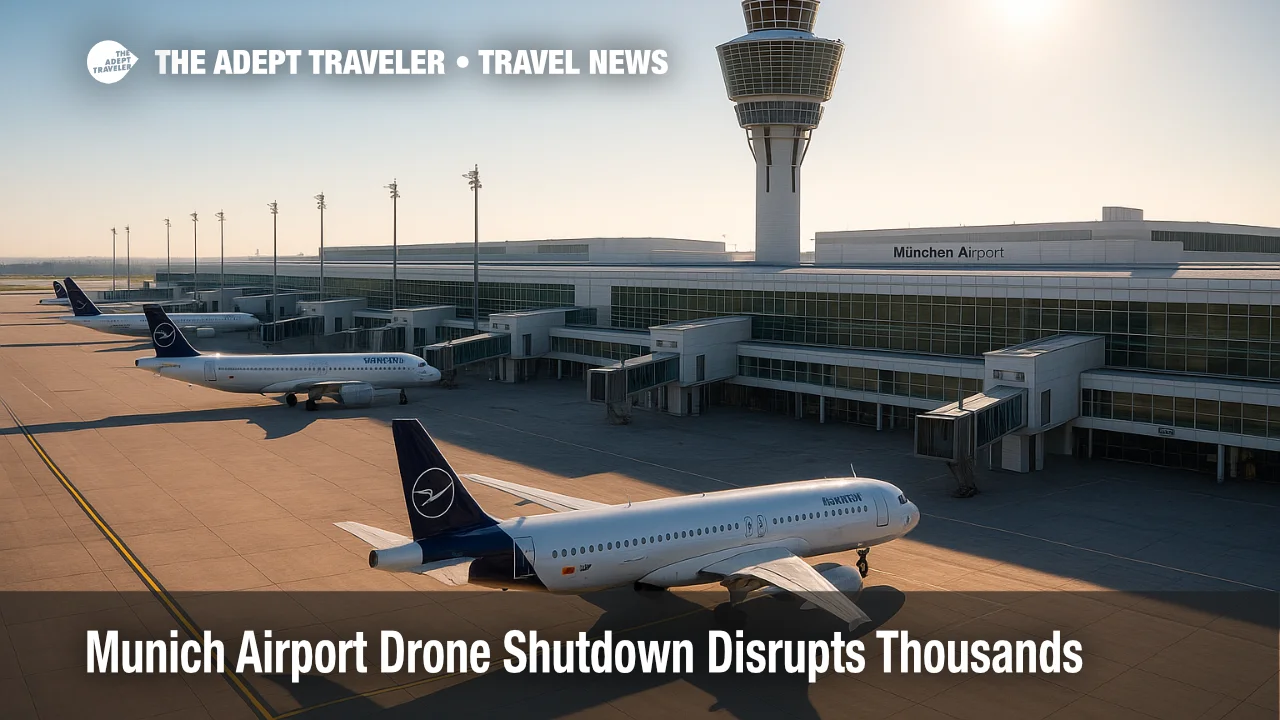Munich Airport drone shutdown disrupts thousands before reopening

Munich Airport (MUC) suspended operations overnight after multiple drone sightings late on October 2, forcing authorities to first restrict, then halt flights. Airport officials said 17 departures were canceled and 15 arrivals diverted to other European hubs as police and federal units searched the airspace. Service began ramping back up around 5:00 a.m. local time on October 3, but residual delays and missed connections continued as airlines, crews, and aircraft returned to position.
Key Points
- Why it matters: A nighttime drone incursion shut Germany's second-busiest airport, stranding about 3,000 travelers.
- Travel impact: 17 cancellations, 15 diversions, and rolling morning delays during the restart.
- What's next: Police investigations continue; German leaders signal tighter anti-drone laws and countermeasures.
- Diversions sent flights to Frankfurt, Stuttgart, Nuremberg, and Vienna during the closure.
- European officials link the incident to a wider pattern of unexplained drone overflights.
Snapshot
German air navigation service DFS restricted traffic at 1018 p.m. on October 2 after several drones were reported near Munich's airfield and later ordered a full stop to departures and arrivals. Inbound aircraft diverted to Frankfurt (FRA), Stuttgart (STR), Nuremberg (NUE), and Vienna (VIE), while outbound late-evening departures were scrubbed. Camp beds and supplies were set up for stranded passengers. Operations restarted around 500 a.m. on October 3, with the airport warning of lingering delays while airlines re-crew and reposition aircraft. Authorities have not confirmed the type or origin of the drones, and no arrests were announced as of publication.
Background
Europe has seen a spate of airport and military-site drone incursions in recent weeks, including a full stop at Copenhagen Airport (CPH) on September 22. German officials say drone activity around critical infrastructure is rising and plan to tighten enforcement and deploy more robust detection and defeat technology. While intentional attribution remains unproven in several cases, European leaders have publicly discussed the risk of state-linked hybrid interference alongside criminal activity and reckless hobby flying. Travelers should expect airports to react conservatively to sightings, especially at night, when identification is harder and runway approaches are busy. For broader context on the regional pattern, see our related coverage of CPH: Copenhagen Airport closure after drone sightings.
Latest Developments
Munich flights resume, but expect residual delays and missed connections
Munich confirmed a phased restart around 500 a.m. on October 3, with 17 cancellations and 15 diversions logged during the shutdown and roughly 3,000 passengers affected. Police and federal units patrolled the area overnight, including helicopter sweeps, but could not verify the drones' size or recover hardware in darkness. Airlines began reaccommodating travelers on the morning wave, prioritizing long-haul connections and scarce crew duty time. If you are transiting Europe in the next 24 hours, monitor your booking apps for rolling rebooks and keep an eye on minimum-connection windows, especially if your itinerary touches constrained sectors over France ahead of next week's ATC action, which we preview here France ATC strike October 7-10: advance notice.
Analysis
Nighttime drone sightings are operationally costly because verification is difficult and risk tolerance is near zero on final approach. The MUC suspension illustrates a pattern: rapid traffic restrictions, a full stop if sightings persist, diversions to nearby hubs, then an early-morning restart with a backlog that takes most of the day to unwind. The diversion set-Frankfurt, Stuttgart, Nuremberg, and Vienna-shows how Southern Germany redistributes capacity when its primary hub blinks offline. Expect policy movement next. Bavaria's leadership is already calling for expedited legislation, and Germany will likely accelerate airport-area counter-UAS deployments that integrate detection, identification, and defeat measures with DFS procedures. For travelers, the practical takeaway is to plan for knock-on effects. Aircraft and crews end up out of place, which can ripple through midday banks and the evening peak. Build buffer on Europe-to-U.S. returns tonight, avoid tight self-connections, and keep digital boarding passes and notifications enabled so you can accept rebooks quickly.
Final Thoughts
The incident underscores how small drones can create outsized disruption in a tightly scheduled network. As regulators push new counter-UAS rules and technology, airports will continue to err on the side of caution, especially at night or in poor visibility. If your trip depends on a MUC connection today, treat schedules as provisional, check gate changes often, and consider earlier positioning flights when possible. Europe's fall travel season remains busy, and a single airfield stoppage can ripple regionally. We will update this story as authorities release findings from the Munich Airport drone shutdown.
Sources
- Press: Drone sighting at Munich Airport, Munich Airport
- Munich airport reopens after drone sightings halt flights, Reuters
- Munich Airport temporarily shut after drone sightings, AP via Washington Post
- Munich airport reopens after halting flights because of drone sightings, The Guardian
- Nach Drohnensichtungen: Flughafen München wieder geöffnet, ZDF
